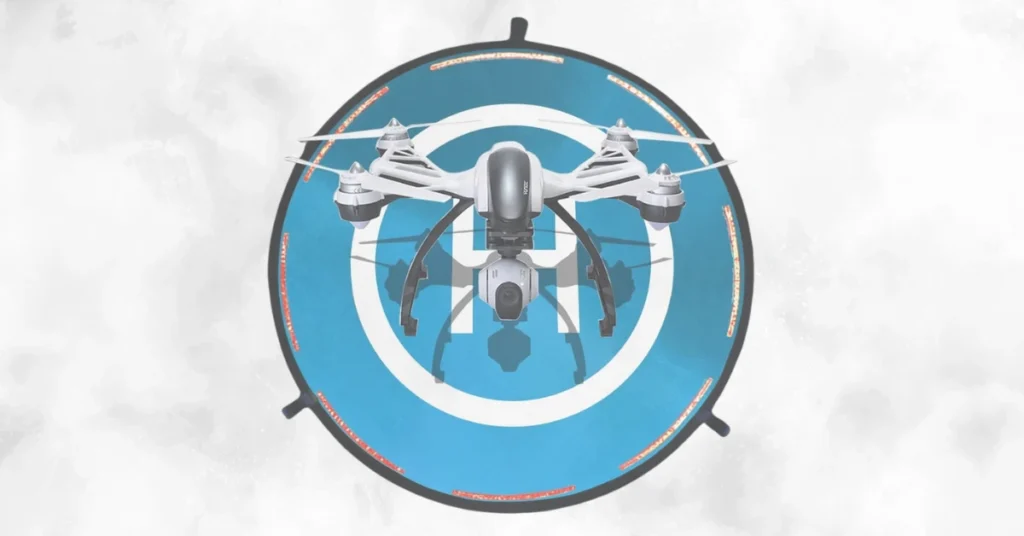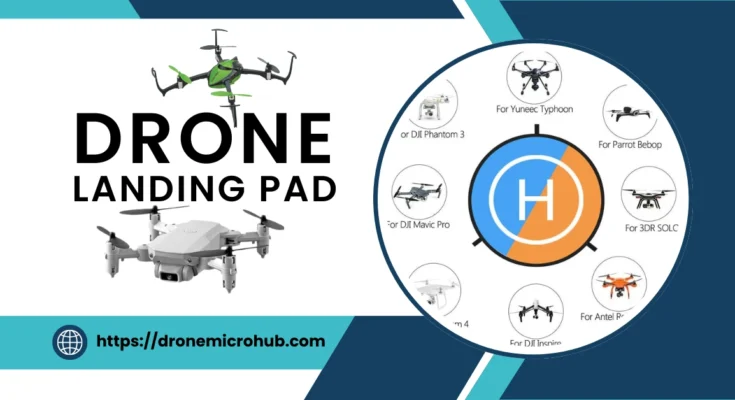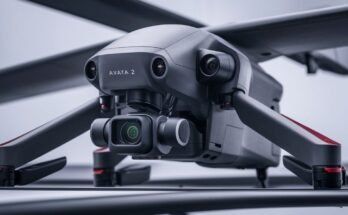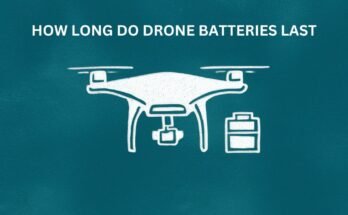Introduction
Drone Landing Pad:
As drone operators, one of the most critical aspects when acquiring your UAV is ensuring it will land safely and effectively every time to prolong its life; all this starts with buying a proper landing pad. Therefore Welcome to “The Ultimate Guide To Choosing The Perfect Drone Landing Pad”.
We’ll walk you through essential points, do-it-yourself alternatives and best options in this guide to support your choice. It is hard to overestimate the value of a good landing pad for both experienced and amateur pilots.
Let’s explore the realm of drone landing platforms and learn how this simple accessory can have a major impact on your drones performance, as well as safety.
Key Factors in Choosing a Drone Landing Pad
One of the most important factors that define its importance when deciding on a drone landing pad includes such features as: 1 Let’s delve into these factors to guide you in making a well-informed decision:
- Size and Dimensions: Your drone landing pad size should be proportional to the size of your drone. A pad that is too small could be problematic at take-off and touchdown, while a large one might require additional effort in transportation. Choose a size according to your UAV’s specifications.
- Material and Durability: A landing pad made from hard and weather-proof materials should be selected. Such materials as high-quality nylon or rubberized fabric are the most popular ones because of their durability and resistance to weariness.
- Portability and Ease of Setup: For active drone fans, portability is essential. Pick a foldable, lightweight and easy to assemble landing pad. This also ensures ease of use during outdoor adventures and provides for an easy transportation solution whenever your drone travels to.
- Visibility and Markings: Increasing visibility is important especially when it’s dark or wide open spaces. Choose landing pads with reflective markings or bright colors that allow the drone’s sensors to detect and align for an easy touch down.
- Stability and Anti-Slip Features: A properly secured landing pad allows the aircraft to avoid any jerk during takeoff or landings. Look for pads with anti-slip grip to provide a solid grip on different surfaces. Rather, stability is important in windy conditions or on uneven surfaces.
- Compatibility with Landing Gear: Pay attention to the design of your drone’s landing gear and find a suitable landing pad for it. Some of the landing pads have adjustable straps or customizable features so that they accommodate various configurations for landing gears.
After a thorough consideration of these crucial factors, you will find yourself in the right platform to choose a drone landing pad that does not only address your UAV specifications but also help bolster other aspects associated with flying.
Below we will discuss DIY alternatives, key factors to consider for safe landings and different types of drone landing pads that are in the market currently.
DIY Drone Landing Pads
For those drone fans seeking individuality or looking to cut costs, a DIY drone landing pad can be both rewarding and practical to make. Here’s a step-by-step guide to crafting your customized landing pad:
- Materials and Tools: Collect the required materials as well as tools like a solid foundation material that can withstand lots of wear and tear such settings plywood or even rubberized fabric, weather proof paint, stencils measuring tape among other things. Use materials that are lightweight but strong.
- Design and Dimensions: Decide the size of your landing pad having in mind about how large or small is your drone and amount of space available for takeoff and landings. Create visually pleasing designs or markings using stencils or templates. Or add your own personal touch or custom graphics to make it truly yours.
- Weather-Resistant Coating: Apply weather-resistant coating to your DIY landing pad in order to protect it from the elements of nature. This step is critical in ensuring the durability and longevity of your artwork, especially if you intend to use it under various outdoor conditions.
- Portable and Foldable Features: In case portability is your priority, make sure to design your landing pad in such a way that it can easily be folded or disassembled. This makes this convenient during outdoor drone adventures. In addition, it may be wise to include handles or carrying case for even more convenient transport.
- Reflective Elements for Visibility: Improve your DIY landing pad’s visibility in darkness by using reflective features. This could range from reflective paint or tape positioned on the surface at strategic points. Enhanced vision leads to a better landing experience.
- Testing and Adjustments: Test your DIY landing pad in the field carefully. Make sure that it provides a steady surface for takeoff and landing, modify if there is the need to improve its performance. This step is the most important to avoid potential problems when performing real robotic flights.
Building your own drone landing pad enables you to adapt it for use at home, but also adds a personal feel when flying. As a hobbyist or professional, having the right DIY landing pad can be an integral part of your drone toolkit.
In the sections below we will look at specific landing pads on offer in the market detailing their connectivity features and advantages to help you decide more clearly. Keep reading to learn more about choosing the ideal drone landing platform for your requirements.
Top Considerations for Safe Landings
Every drone pilot needs to ensure safe landings, and the selection of a proper landing pad is an important aspect towards achieving this objective.
Let’s explore the top considerations that contribute to safe landings and how they impact your overall drone flying experience:
- Surface Stability: One of the major factors is stability of the landing surface. A good drone landing pad is a flat and smooth surface that your UAV will both take off from and land on, minimizing the chances of tilt or uneven touch-downs.
- Impact Absorption: Look for pre-built landing pads with features that can absorb impact. This can assist to reduce the shock and stress on your drone’s sensitive components during landing, prolonging the life of your UAV.
- Protecting Gimbal and Camera: A good designed landing pad shields your drone’s gimbal and camera from dust matter on the ground. This is especially the case during takeoff and landing, when small particles can be stirred up to potentially cause harm to these delicate parts.
- Contrast for Precision Landings: Choose high-contrast markings or colors of landing pads. This improves visibility and supports precise landings precisely when the drone’s sensors depend on visual cues for pinpoint positioning.
- Weather Resistance: Adverse weather conditions might affect the safety of your drone operations. Select a weather-resistant landing pad capable of handling different elements like rain, snow or gusty winds. This makes consistent performance in different environments.
- Anti-Slip Features: Look for landing pads with antiskid properties to prevent unintended movements during takeoff or landings. These provide a strong grip on the surface, even in difficult situations which also helps to improve overall stability of your drone.
- Size Compatibility: Make sure that the landing pad is large enough for your drone. A pad that is too small can create problems during the landing, while a large one might not be convenient to carry around. Make sure it fits your drone size and landing gear arrangement.
- Reflective Markings for Low-Light Conditions: If there are often flights in low-light conditions, select a reflective marking landing pad. This enhances visibility during night or early morning flights thereby reducing chances of misjudging the runway while landing.
In the following sections, we will delve deeper into various drone landing pads that have been introduced in the market each serving different purposes and requirements.
Keep reading to learn about weather-proof options, transportable designs and so on as we take you through the selection process for ideal drone landing mat for your UAV.
Exploring Different Types of Drone Landing Pads

In the evolving realm of drone technology we have witnessed the emergence of kinds of landing pads. These landing pads are specifically designed to cater to the requirements and preferences of drone pilots.
So let’s take a dive into the types of drone landing pads that are currently available, in the market and explore their distinctive features.
- Foldable and Portable Landing Pads: Ideal for drone enthusiasts on the move, foldable and portable landing pads offer convenience during outdoor adventures. These pads are designed to be compact, lightweight, and easy to carry, making them suitable for travel and on-the-go drone missions.
- Helipad-Style Landing Pads: Inspired by helipad designs, these landing pads often feature large and visually distinct markings. The helipad-style design enhances visibility, aiding precision landings, and adds a professional touch to your drone setup.
- Waterproof and Weather-Resistant Pads: For pilots navigating unpredictable weather conditions, waterproof and weather-resistant landing pads are essential. These pads are crafted from materials that repel water, ensuring consistent performance even in rain or snow. They also resist damage from exposure to sunlight and other environmental elements.
- Light-Up Landing Pads: Innovative light-up landing pads cater to pilots who fly during low-light conditions. These pads often come equipped with built-in LED lights, providing illumination for takeoffs and landings. The added visibility enhances safety and adds a visually striking element to your drone setup.
- Helipad Mats with Weighted Corners: Designed for stability, helipad mats with weighted corners ensure that the landing pad stays securely anchored, even in windy conditions. The weighted corners prevent the pad from lifting or shifting during takeoff and landing, contributing to a safer and more controlled landing experience.
- Landing Pads with Built-In Cases: For those who prioritize protection during transport, landing pads with built-in cases offer a convenient solution. These pads can be folded or disassembled and stored within their dedicated case, providing both portability and added protection against damage.
- Customizable Landing Pads: Some landing pads allow for personalization and customization. Pilots can add their own graphics, logos, or designs to make the landing pad uniquely theirs. This option caters to those who want to express their individuality in their drone equipment.
When you explore the types of landing pads for drones you’ll discover a range of options available, in the market. To choose the landing pad that suits your drone piloting style consider your needs, flying conditions and personal preferences.
In the following sections we will provide information on landing pads features to help you narrow down your choices. Stay tuned for details, on weather options, stability features and other factors that will assist you in selecting an ideal landing pad for your UAV.
Weather-Resistant Features in Drone Landing Pads
Weather conditions can be unpredictable, posing challenges to drone pilots during takeoff and landing. A key consideration when choosing a drone landing pad is its ability to withstand various weather elements.
Let’s explore the importance of weather-resistant features and how they contribute to the durability and reliability of your landing pad:
- Material Selection: The choice of materials plays a pivotal role in determining a landing pad’s resistance to weather. Opt for landing pads made from durable and weather-resistant materials such as high-quality nylon, rubberized fabric, or PVC. These materials not only endure exposure to sunlight but also repel water, ensuring consistent performance in different weather conditions.
- Waterproof Coating: A waterproof coating adds an extra layer of protection to your landing pad. This coating prevents water from seeping into the material, safeguarding it against rain, snow, or damp surfaces. Waterproof landing pads are particularly crucial for pilots operating in regions with frequent precipitation.
- UV Resistance: Extended exposure to sunlight can lead to material degradation. UV-resistant landing pads are designed to withstand prolonged exposure to sunlight without fading or weakening. This feature enhances the pad’s longevity, making it a reliable accessory for outdoor drone flights.
- Quick Drying Design: In instances where your landing pad gets wet, a quick-drying design is beneficial. Landing pads with quick-drying properties ensure that the surface becomes usable shortly after exposure to rain or other moisture, allowing you to resume flying without extended delays.
- Wind Resistance: Consider landing pads with features that enhance wind resistance. This is particularly important in windy conditions where a stable landing surface is crucial for safe operations. Look for pads with weighted corners or anchor points to prevent lifting or shifting in the wind.
- Foldable and Compact Options: For pilots frequently on the move, choosing a weather-resistant landing pad that is foldable and compact adds an extra layer of convenience. These pads are easy to store, transport, and deploy, making them suitable for various outdoor environments and weather conditions.
Choosing a drone landing pad with robust weather-resistant features ensures that your UAV operations remain consistent and reliable regardless of the weather. By prioritizing these features, you’re not only investing in the safety of your drone but also extending the lifespan of your landing pad.
In the subsequent sections, we’ll continue to explore additional features and considerations, guiding you toward selecting the perfect drone landing pad for your needs. Stay tuned for insights into stability features, anti-slip properties, and other factors critical to a safe and enjoyable flying experience.
Comparing Drone Landing Pads with Natural Surfaces

As drone pilots, the choice between using a dedicated landing pad and relying on natural surfaces for takeoff and landing is a decision that merits careful consideration. Let’s delve into the comparison between drone landing pads and natural surfaces, exploring the pros and cons of each to help you make an informed choice:
- Stability and Level Surface: Landing Pads: Dedicated landing pads provide a stable and level surface for your drone. This stability is crucial during takeoff and landing, minimizing the risk of tilting or uneven landings. Natural Surfaces: Natural surfaces, such as grass or gravel, may lack the consistent stability that a landing pad offers. Uneven terrain can pose challenges, especially for drones with low clearance.
- Protection for Components: Landing Pads: Using a landing pad offers protection for your drone’s delicate components, such as the gimbal and camera. The smooth surface minimizes the risk of debris causing damage during takeoff or landing. Natural Surfaces: Landing on natural surfaces exposes your drone to potential debris and uneven terrain, increasing the risk of damage to sensitive components.
- Precision Landings (Drone Landing Pad): Dedicated landing pads often feature markings or designs that aid precision landings. This is particularly beneficial for pilots who rely on visual cues for accurate positioning. Natural Surfaces: Achieving precision landings on natural surfaces can be challenging, especially in areas without distinct markings or visual references.
- Convenience and Portability: Landing Pads: Designed with portability in mind, landing pads are often foldable and easy to transport. They can be carried in a drone backpack, making them convenient for on-the-go pilots. Natural Surfaces: While natural surfaces are abundant, they may not always be convenient or suitable for drone takeoff and landing. Certain environments may lack appropriate areas for a safe operation.
- Weather Impact: Landing Pads: Weather-resistant landing pads are designed to withstand various weather conditions, providing a reliable surface for your drone even in adverse weather. Natural Surfaces: Weather conditions can significantly impact natural surfaces. Wet or muddy terrain, for example, may pose challenges to safe takeoff and landing.
- Maintenance and Longevity: Landing Pads: Regular maintenance of landing pads involves simple cleaning and occasional checks for wear. Well-maintained landing pads can offer longevity and consistent performance. Natural Surfaces: Landing on natural surfaces may expose your drone to more wear and tear, potentially requiring additional maintenance and cleaning.
When pilots are deciding between using a drone landing pad or natural surfaces they need to take into account their requirements the environments they fly in and the level of accuracy needed for their flights.
Whether you opt for the convenience of a landing pad or the flexibility of surfaces having an understanding of these factors will enhance your drone flying experience by making it safer and more enjoyable.
Keep reading to discover maintenance tips and best practices that can help prolong the lifespan of your chosen drone landing pad.
Maintenance and Longevity
Tips for Your Drone Landing Pad:

Ensure that your drone landing pad is in good condition so as to guarantee its durability and efficiency. Here are practical tips to keep your landing pad in top condition:
- Regular Cleaning: Clean your landing pad regularly to remove dirt, debris and moisture build up. Clean the surface with a soft brush or damp cloth but gently. This ensures that contaminants do not reach the material used on landing pads and makes them ready for safe takeoffs and landings.
- Check for Wear and Tear: Check for ragged edges, punctures or surface damage. In order to prevent the situation from getting worse, it is important that you address these issues as soon as possible and hence prolong your landing pad’s lifespan.
- Store Properly: When you do not use your landing pad, put it in a cool and dry place. If your landing pad is foldable or collapsible, make sure to follow the manufacturer’s instructions for correct storage. This ensures that unnecessary exposure to elements is minimized and well protected thus keeping the pad structurally intact.
- Repair Minor Damage: If you notice minor damage, such as small tears or scratches, consider repairing them promptly. Many landing pads come with repair kits or simple solutions for patching up small issues. Taking care of minor damage can prevent it from escalating into more significant problems.
- Protect from Harsh Weather: While weather-resistant landing pads are designed to withstand various conditions, it’s advisable to protect them from extreme weather when not in use. Prolonged exposure to harsh sunlight, heavy rain, or strong winds can impact the material over time.
- Rotate Landing Positions: To ensure even wear, rotate the landing positions on your landing pad. This is especially relevant if you frequently use specific areas for takeoff and landing. Rotating positions helps distribute the impact and maintains a more consistent surface.
- Use Proper Cleaning Agents: When cleaning your landing pad, use mild cleaning agents that are compatible with the material. Avoid harsh chemicals that may damage or degrade the landing pad’s surface. Follow the manufacturer’s recommendations for cleaning products.
- Patch Larger Damage Professionally: If you encounter larger tears or damage that cannot be easily repaired with a DIY solution, consider seeking professional assistance. Many manufacturers or repair services specialize in fixing more extensive damage, ensuring the continued functionality of your landing pad.
By incorporating these maintenance tips into your routine, you can significantly extend the lifespan of your drone landing pad. A well-maintained landing pad not only enhances the safety of your drone operations but also ensures a reliable and stable surface for countless takeoffs and landings.
In the final section of this guide, we’ll delve into best practices for using your drone landing pad effectively, bringing together all the elements discussed to optimize your overall drone flying experience. Stay tuned for valuable insights into maximizing the benefits of your chosen landing pad.
Conclusion:
In conclusion, selecting the perfect drone landing pad is a critical decision that significantly influences the safety, stability, and overall enjoyment of your drone flying experience. By understanding key factors such as size, material, and portability, you can make an informed choice that aligns with your specific needs.
Whether opting for a weather-resistant pad for diverse conditions, a foldable DIY solution for personalization, or a helipad-style design for added visibility, each option comes with its unique advantages.
The comparison between dedicated landing pads and natural surfaces highlights the importance of stability, protection, and precision in choosing the ideal landing location for your UAV. Furthermore, maintaining your landing pad through regular cleaning, inspections, and proper storage ensures its longevity and continued reliability.
By following best practices, you can maximize the benefits of your chosen landing pad, contributing to safer takeoffs, landings, and an overall enhanced drone piloting experience. As you venture into the world of drone flight, may your landing pad be a steadfast companion, paving the way for countless successful and enjoyable aerial adventures.





2 Comments on “Drone Landing Pad | The Ultimate Guide to Choosing the Perfect Landing Pad”